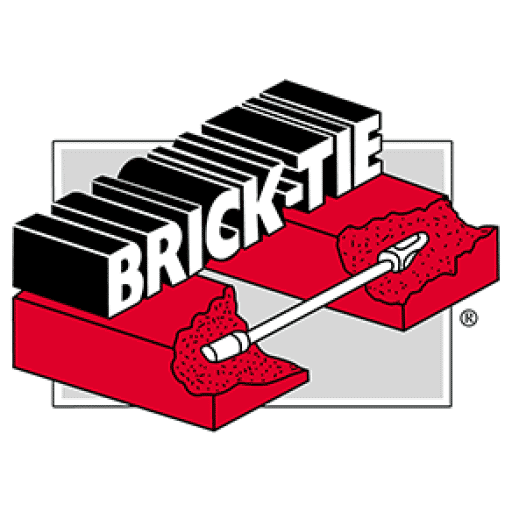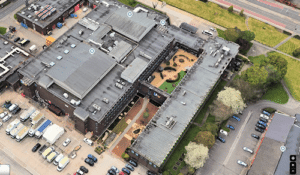SockFix case Study St Joseph’s Presbytery near Preston
Brick-Tie successfully repairs a 300-year-old building, through SockFix installation of an anchor system and the Helifix remedial system, without damaging the historic fabric. Lots goes into making sure a job like this works for the client and the building so, where structural repairs of ancient buildings are concerned – what needs to be considered?
Very old buildings need special care when structural issues strike. St Josephs dates back to 1677, though the adjacent Stanfield House; the ‘Priest’s House’, was added in 1730
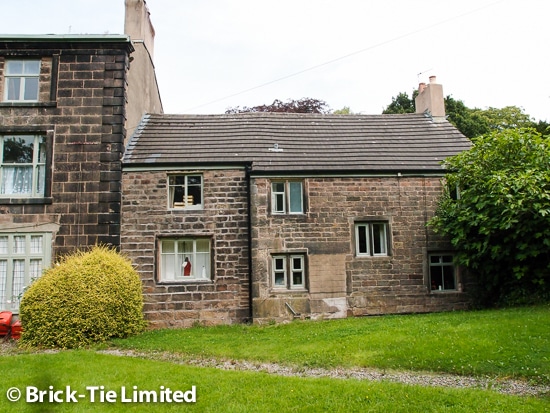
Benedictine monks have cared for the building from the beginning and when cracking was found they turned to a structural engineer for advice.
Some of the cracks were up to 30mm wide, causing damage to the plasterwork and masonry. In addition cracks were present in old stone lintels and the walls were bulging.
After a careful appraisal engineers called in Brick-Tie for further advice. Our MD Bryan Hindle takes up the story “Use of the Helifix Sock-Fix anchor system and Helifix HeliBars was already on the cards, but my task was to asses the practicalities of using these materials, specifying the dimensions required, choose the best position for them and evaluate any adverse impact the work could have”
Asked what adverse effects could occur during structural repairs Bryan is quick to reply “More than most people think” he says “very old buildings are constructed in a lime mortar and often the stone itself can be quite soft. We need to consider the method of installation, the interaction between the new materials and the old ones and also long term damage, which could come from changing the dynamics in the masonry; porosity and thermal movement; more to the point, avoiding too much resistance to evaporation or to cyclical micro-movements”.
Taking the above into account Brick-Tie chose the equipment carefully as well as the materials “We never use powerful rotary hammer drills on these structures, they’d shake the masonry too much” he adds “for smaller diameter wall ties and anchors, low percussion drilling is suitable most of the time. For larger SockFix anchors wet diamond core is best, it’s low vibration”.
Why Use Larger Diameter Pilot Holes for SockFix Anyway?
“Well sometimes, we do need a long and strong anchor, which is where the SockFix Anchor system comes in. However, when stitching soft masonry you need to consider the strength of the substrate, in relation to the installed anchors. By enlarging the pilot hole a little, the bearing stresses at the wall/anchor interface are reduced by a considerable margin”.

He explains the above with a simple analogy “If for example there was a large sheet of damp paper on a desk and you grabbed a corner between finger and thumb, to pull it towards you, you wouldn’t be surprised if the corner just tore off, leaving the sheet behind would you? This happens because the force needed to move the paper was greater than the paper’s strength” Asked why that is relevant to the SockFix anchor system Bryan smiles “I’m guessing that if you did tear that paper you’d then grab it again with several fingers or two hands? That would allow you to pull it towards you with no tearing – all you’ve done is apply the same force, but spread over a wider area – simple”
Brick-Tie technicians were using the Helifix remedial repair system too, so why not just install more of these smaller helical ties to have the same effect?
“Ah” says Bryan “well spotted; we often use several weaker ties instead of one big strong anchor for that reason. However, here, we are dealing with rubble filled walls with large voids. In these cases it’s almost impossible to achieve good encapsulation of Helical ties within their grout matrix. The Sockfix Anchor system, with its expanding sock technology, allows filling of the pilot hole with grout injected via the remote end of the tie. When the installer sees the grout at the near end, he knows that full encapsulation of the SockFix stainless steel core has happened” Does this matter? “Hell yes, if you don’t get that great snug interface along the length and circumference of the tie, you are back in the territory of over-stressing the wall at the reduced tie/wall interface”.
The larger pilot holes were chosen to reduce the stresses on the wall and care was taken to ensure that when plugged, these were virtually invisible. Many meters of Helifix HeliBars were needed too and the method of installation was crucial. This was done using hand-chasing of the bed-joints, to avoid use of grinding wheels, which could otherwise damage the masonry.
What was the Main Role of the Helifix Helibars on this Project?
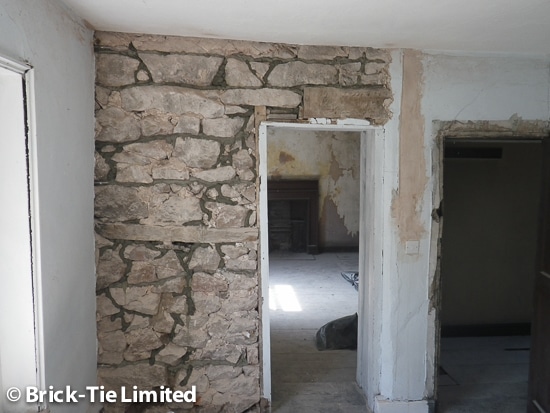
“Cracks beget cracks I’m afraid” shrugs Bryan “If movement has happened, even if it’s not progressive, cracks are a permanent weak point and, a building will tend to use them as natural expansion joints from here on, causing them to re-occur later” This problem was solved with 6mmm diameter HeliBars in Helifix Helibond grout.
Is the Grout Product that Crucial in Old Buildings?
Helibond grout is a polymer modified thixotropic grout. Asked to explain why this is important in listed or old building Bryan returned to the issue of lime and movement “If you use something say, like a generic cementitious grout you can cause irreparable damage. Cement is always going to be much harder than lime mortar, this is a fact. However, Helifix bed-joint reinforcement placed in deep chases, recessed well below the surface in Helibond grout, should not be a problem for an old building”.
The trouble is in the details though says Bryan; “some grouts shrink quite a bit as they set and dry out. They are strong though, much more so than the lime surrounding them. It is at his stage that damage happens; the hard grout induces tension at the interface between the grout and the lime and so the soft lime rips along the bed and a weak bond is the result. What you are left with then is a weak repair and worse still, a nice crack for water penetration. The last thing you want is water behind the dense grout – that leads to freeze/thaw damage and stone erosion”.
The thixotropic nature of Helifix Helibond grout is essential, particularly in old buildings as Bryan outlines “The grout must be fluid enough to inject into the deep chased bed-joints, however. If there is any tendency for the placed grout to slump, we are in trouble, because small voids means cracks for water ingress and as I said before, increased bearing stresses. Helibond is a joy to use, far better than some of the cheaper grouts available for this work, there’s no slump at all and once HeliBars are set into it, it stays put – great!”
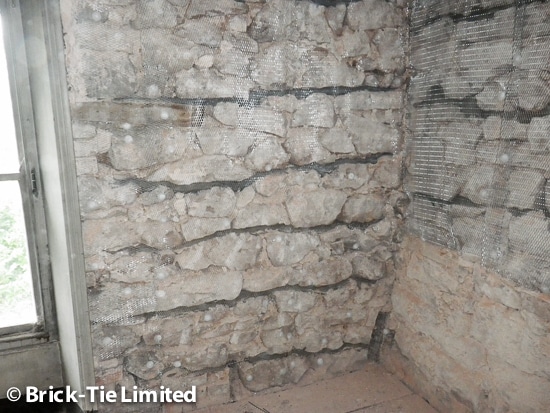
What Else Needs to be Considered for this Historic Building?
The work needed a re-pointing element and some of the stones required repairs. This was done using natural lime and coarse sand, in keeping with the materials originally used to build the Priest’s House. These are materials which had virtually died out by the mid twentieth century, but are making a real comeback these days, as Bryan explains “They died out because compared to cement, lime can be a pig to use – lime takes no prisoners if you don’t respect it. The mix must be bang on, the sand should be well graded and not at all loamy, too much suction and it will shrink and crack, so that must be controlled. You can’t slap on a huge thickness either and if you don’t protect it from frost or the sun you’re in trouble again”

If it’s That Awkward, Why Use Lime Mortar?
“These building are porous and rain soaks into the bed-joints and stones. It’s not all bad though because when the sun shines and the wind blows, they also let that water out very freely. Cement is much denser and whilst water will always get in, drying is slow. The results of using cement on these buildings can be increased freeze/thaw action and irreversible damage to the stones themselves, which are irreplaceable” Bryan is passionate about this “The important thing is good training and experience – also knowing your limitations. My technicians respect the natural materials and realise you can’t rush this work – you have to be patient”

The Repairs
- SockFix anchors in the role of corner stitching through rubble filled walls – diamond core drilled
- Helifix HeliBars in a role of crack stitching and lintel repairs – hand chased
- Helifix HD Bowties for provision of lateral restraint through the walls and into the floor timbers – low percussion
- Plastic stone repair mortar for masonry repairs
- Natural lime mortar for the repointing
For expert advice on the use of SockFix, Lime pointing or Helibar repairs call us free on 0800 591541 or use the contact us page.
The following links give further information too.
https://www.bricktie.net/structural-repairs/
